There are a thousand and one memorable ways to incorporate ambient recordings into your music. Reverse them, warp them, time stretch them, pitchshift them, throw filters and effects at them or just use them clean. But first you need to capture them, and for this you’ll be wanting the best field recorder you can get your hands on.
Think of an inebriated Bowie, adding a recording of a steam train to his seminal track Station to Station. Or, more recently, Finneas building hits for his sister Billie Eilish by manipulating everyday sounds such as the metronomic click of a pedestrian crossing (Bad Guy), or the fizz of a striking match.
A field recorder is a great investment if you want to add some creative originality to your tracks. And, the cost can be modest too, with many recorders here costing below $/£/€200.
Of course, if you want to record the sounds of nature, like the supremely talented ex-Cabaret Voltaire muso Chris Watson, a podcast or dialogue for a YouTube video then a field recorder is perfect for this too.
We've included some in-depth buying advice at the end of this guide, so if you'd like to read more about the best field recorders, click the link. If you'd rather get to the products keep scrolling.
Best field recorders: Our top picks
Interested in a well-specced field recorder that won't break the bank? Then take a look at the Tascam DR-40X. It has many features that musicians will adore, including balanced XLR inputs, a tuner, a four-track mixer with over-dubbing and dual recording. What's more it doubles up as a class compliant USB audio interface.
The new Zoom H8 Handy Recorder is a beast of a machine. In fact, it's pretty much a recording studio in box. Eight inputs and 12 tracks will enable you to get very creative with your subjects and sources – there are six or more Zoom mic capsules to choose from, plus any mics or outboard gear you already own.
The Zoom H8 also features dedicated modes for podcasters, musicians and field recordists, making this a versatile top choice for creators.
Best field recorders: Product guide

Tascam has musicians firmly in its sights with the DR-40X. Not only does it feature two balanced XLR inputs for additional mics, or connection to a mixer, but it also operates as a class-compliant audio interface over USB 2.0. Thankfully, the XLR inputs don't override the built-in mics, making the DR-40X a true four-track recorder/interface.
The DR-40X is littered with other musician-friendly features too, including a basic but very welcome mix facility. You can play back all four tracks simultaneously, while adjusting both the mix and pan of each individual track.
Six different reverb effects, which can be applied to the input or output signal, are on tap to make your band sound suitably vast and the onboard tuner will keep you all in tune. The perfectionist in you can also overdub as many takes as needed and, when happy with the result, bounce the tracks down to a final mix.
Tascam has implemented its own version of dual recording, which provides more headroom by recording a second safety track at a slightly lower level to capture any wayward spikes distortion free. There's is also a peak reduction feature, and a limiter, to ensure clean, idiot-proof recordings.
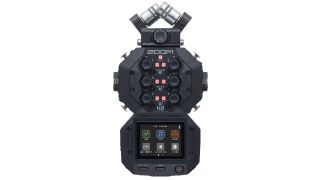
The new Zoom H8 may look like the unfortunate love-child of Transformers' hero Optimus Prime and a Nintendo Gameboy but there's nothing '80s about the tech. Zoom is well-known for its innovative product line – from the budget H1n right up to the pro-level F8n – but the Zoom H8 is possibly its most ground-breaking yet. It has managed to pack an awful lot into its characterful, if slightly awkward-looking, robotic form.
This is a recorder firmly targeted at the new-breed of creators. Whether you're a musician, a podcaster or a field recordist the Zoom H8 has dedicated modes just for you. A whopping eight inputs and 12 tracks means that you're unlikely to run out of sonic capacity, but if you do, you can remove the included mic capsule and replace it with a further four XLR inputs. Or you can swap the included mic capsule with one of more than half a dozen other mic options including an Ambisonic array.
The large high-resolution touch screen is a joy to use, especially for monitoring levels. Of course, there's the obligatory phone app that covers similar ground, but the built-in screen feels more immediate. Zoom likes to call it a 'Handy Recorder' but it's so much more. You can mix, trigger sound pads, overdub and even connect to Zoom's Guitar Lab for a huge assortment of amps and effects. Plug it into your laptop and it serves as a USB interface too.
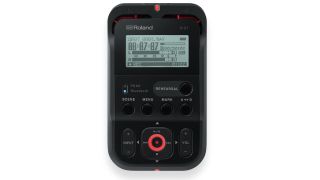
Roland's baby recorder has a surprisingly grown-up feature set. This fun-sized marvel just begs to be taken everywhere with you, always ready should inspiration strike. It's dead-simple to use – hit the big Rehearsal button to automatically set levels and you're good to go.
Additionally, Roland has included ten parameter preset 'Scenes' that fine-tune the R-07 for common recording needs – Loud Practice, Vocal, Field and so on. Select the most appropriate Scene and the R-07 sets an optimal configuration. Dual recording provides a back-up track recorded at a lower level for increased headroom too.
Its Bluetooth capabilities are genuinely useful, enabling you to place the R-07 close to the action but control it from a distance. It may not give you quality on a par with bigger, heavier, feature-laden recorders, but its portability and simplicity mean it will spend less time languishing in a drawer and more time capturing those priceless, unexpected moments.
Read the full Roland R-07 review
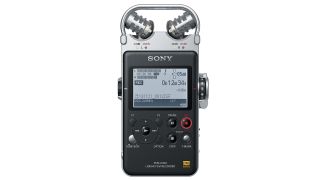
The Sony PCM D-100 is built like a tank. Its sturdy aluminium frame and scaffold-like mic cage make it look and feel reassuringly robust – drop it and the pavement will probably come off worse. This is a no-nonsense field recorder that's aimed squarely at the pro end of the market and it has a price point to match.
There's no fancy Bluetooth app, and it won’t help you tune your guitar. Instead, every effort has gone into making sure the PCM D-100 captures the best recording possible, whatever the location or the conditions. Preamp circuitry is isolated from its power supply for reduced noise, and levels can be set for each mic. These can be positioned independently too, swiveling 90 through 120 degrees.
Unusually, the PCM D-100 can record in DSD format, which some audiophiles believe sounds smoother and more 'analogue' than PCM. It's just a shame it doesn't feature balanced XLR inputs. It would be awesome to hook it up to some top-notch mics to take advantage of its fabulous sound capabilities...
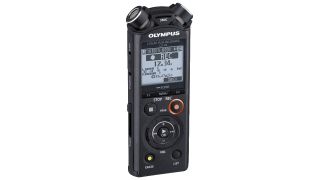
The Olympus LS-P4 is tiny, no bigger than a twin-bar Kit Kat, and weighs in at a diminutive 50g. But it's certainly no lightweight when it comes to recording audio. Where most other field recorders make do with two microphones, the pint-sized (hardly even a swift half, to be accurate) LS-P4 somehow manages to fit in three.
Olympus' clever TRESMIC 3 system uses two outer microphones to capture a natural stereo image, while the omnidirectional centre microphone picks up the low-range. The resulting audio quality does have a pleasing low-end richness to it, which is quite remarkable for a unit of this size. If necessary, the stereo field can be narrowed to taste, via the +/- buttons on the control panel.
It's fair to say that this recorder is aimed at people who value simplicity over complexity, but it's easy to set recording levels, and engage the limiter and low cut filter, if you'd rather not be reliant on its Auto preset modes. The LS-P4 can record in lossless FLAC format, for smaller file sizes, and can stream audio over Bluetooth too.
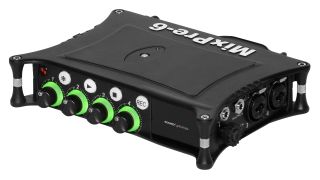
Sound Devices is an iconic brand in the world of film and TV. Its pricey 800 and 600 series recorders are simply legendary, widely regarded as go-to devices for capturing location audio for Hollywood blockbusters, such as Oscar winner The Revenant. The recently launched MixPre II range is more wallet-friendly – ideal for sound designers, podcasters and musicians nervous at the prospect of having to sell a kidney to buy into the brand.
Its 32-bit Float implementation is astonishing. Simply put, this increases headroom to such an extent that there's no real need to bother setting levels – any waveforms that appear clipped in your DAW just need to be normalised. The MixPre-6 II is primarily a recorder but can also be used as a fully-fledged mixer and an 8-in, 4-out USB interface. Four quality Kashmir preamps deliver pristine, noise-free audio, making the MixPre-6 II ideal for ambient recordings in quiet surroundings.
The optional $99 Musician Plugin turns the MixPre-6 II into a portable multitrack studio complete with overdubbing and track bouncing, punch in/out, reverb and a metronome. This means you can record and produce a small band without the need for a laptop or DAW.
Gain levels are so clean and high it will drive a notoriously gain-hungry Shure SM7B mic (a podcaster favourite) without recourse to a Cloudlifter. This makes it perfect for podcasters looking for an all-in-one record, mix and stream solution.
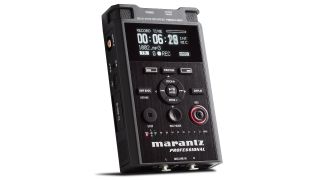
The Marantz PMB-661 Mk III may be a little heftier than other 'pocket' recorders, but it's refreshing to see that it features two balanced XLR inputs, ready to take alternative external mics should you want to override the built-in stereo pair. Trust us, as you get more into field recording having the option to plug in the right mic for your subject is a blessing.
Another feature we love is the line of bright input LEDs along the bottom of the unit. This may sound like a minor thing, but it's so much easier to monitor levels with this eye-catching array of colourful lights than it is trying to make out what's going on in a typically cramped screen, especially from a distance.
The PMB-661 Mk III has a relatively limited feature set for musicians, but if you need to record round-table discussions for podcasts then it does come complete with an omni-directional boundary mic to capture 360-degree audio. It also includes password-protected file encryption for those recording interviews of a sensitive nature. Very Jason Bourne…
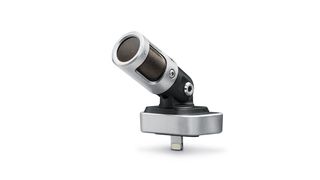
Why bother buying a dedicated recorder when you probably already carry one around with you anyway? If you own a modern smartphone, chances are it will suffice for the odd field recording, saving you any extra expense. And, if your phone happens to be an iPhone then you can up the quality by adding a Shure MV88 bolt-on microphone.
This lightweight condenser microphone is controlled by Shure's simple, yet sophisticated, ShurePlus app that enables you to choose an appropriate recording preset, and fine tune characteristics such as stereo width and mic configuration. It's a tiny device that tucks neatly into a little carry case, complete with a useful (essential) windshield.
The elephant in the room is Apple's lightning connector. European regulators are putting pressure on Apple to ditch its Lightning connector in favour of a universal standard such as USB-C. If they are successful, then the MV88 may be forced into early obsolescence.
Read the full Shure MV88 review
Best field recorders: Buying advice

What should I know about field recorders?
MusicRadar's got your back
Field recorders broadly fall into two camps: easy-to-use recorders that fit in the palm of your hand, with their own built-in microphones, and more sophisticated units that look a little like regular audio interfaces. The latter don't usually have built-in mics, but they will usually feature at least four balanced XLR inputs for extended audio possibilities.
With so many musicians embracing the role of creator, it's good to know that some field recorders of both types double up as mixers and interfaces. Perfect for podcasters, videographers and for making demos of singer songwriters and small bands.
All the recorders featured here are capable of excellent quality with none falling below the 96kHz/24-bit resolution threshold, which is more than ample for most scenarios. But, broadly speaking, there is a quality vs size trade-off. The larger the device the more likely it is to boast better quality components or features that enable you to capture higher-grade audio.
Why should I buy a field recorder?
So, do you want a device that will easily travel everywhere with you, ready to snatch everyday sonic surprises at the press of a button? Or will your recording sessions be more planned affairs, with the aim of making a definitive, quality recording?
If you choose to go down the pocket route, then twin mics that swivel to give you AB and XY configurations are a useful option. They enable you to record a focused stereo field for nearby sources – such as a guitar-toting singer-songwriter – or a wider field for an ensemble of singers. The ability to set recording levels independently for each mic is a real plus-point too.
Every recorder will feature some kind of limiter, which should protect your recording from sudden audio spikes, such as an unexpected loud noise. After all, who knows what your subject is about to do, play, sing or bark?
Some go further with a feature called dual recording. A second safety track is recorded alongside the main track but at a lower level. If the audio spikes at any point then that part of the second track will be substituted, effectively giving you more headroom and a failsafe recording. Better still, 32-bit float recording gives you so much headroom you won't ever have to worry about setting levels again.
How to get the best results
To get the finest possible results, it's best to place your recorder right in the action – just where you can no longer see or reach the controls is usually the perfect place! So, a bundled app for your phone can be a godsend, enabling you to check levels and control your recorder from afar. If you plan to record outside then a fluffy windshield is a must, so check to see if one is thrown in.
Once you get hooked, your recording sessions will become more ambitious and you'll be dying to experiment with better quality external microphones. Our advice is to consider recorders with balanced XLR inputs from the start. Then, you're less likely to outgrow your first recorder too quickly.
Multi-channel recorders give you lots of tracks to play with. You can record a whole drum kit, multiple podcast guests, and configure sophisticated mic arrays for nature. Some, like the Zoom H8 and the Sound Devices MixPre-6 II, are so sophisticated that they rival basic DAWs, freeing you from the tyranny of your laptop.
Find out more about how we test music gear and services at MusicRadar.
Related buying guides
- Best budget studio headphones for performance on a smaller budget
- Best budget microphones: our pick of budget mics for the studio and stage
- The 10 best laptops for music production right now
- Or the best budget laptops for cheap home recording
- The best studio headphones for music production
- The best microphones for recording instruments, vocals and podcasts
- The best podcasting microphones: record your first podcast today


